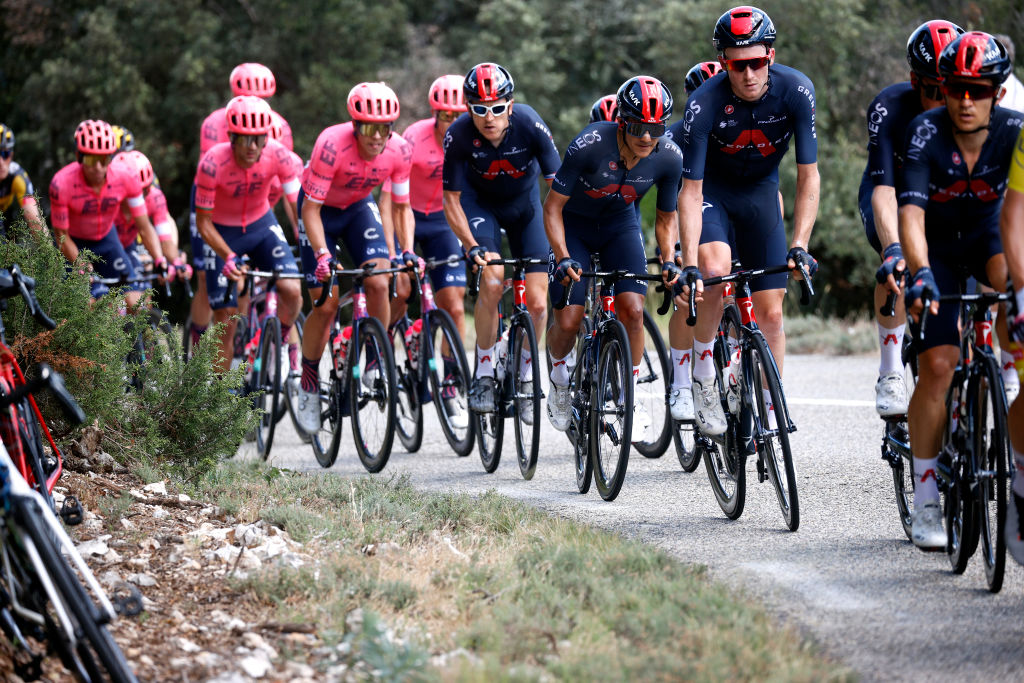Richard Carapaz: The Tour de France isn’t a sprint, it’s a marathon
Ecuadorian says Ineos Grenadiers current race strategy is 'to wear down the opposition'

Ineos Grenadiers' Tour de France leader Richard Carapaz has explained that rather than launching a direct attack on his rivals, his team’s current strategy both on the Mont Ventoux on Wednesday, and in general, is “to wear down the opposition”.
As part of that strategy, Ineos Grenadiers set the pace for much of Wednesday’s double ascent of the ‘Bald Mountain’, with Carapaz only falling back when Jonas Vingegaard (Jumbo-Visma) peeled away close to the summit.
Carapaz and Rigoberto Urán (EF Education-Nippo) then bridged across to Tadej Pogačar (UAE Team Emirates) before the top of the climb, and after a headlong descent to Malaucène, Carapaz moved up to fourth overall.
As Carapaz told a small group of reporters at the start of stage 12, the ‘death by a thousand cuts’ strategy, rather than a knock-out blow, chimed perfectly with his understanding of how Grand Tours tend to play out.
“I always say the Tour is no sprint, it’s a marathon and the longer you’re up in the top positions, the better your chance of success long-term,” Carapaz said.
“The team’s strategy is wear out and wear down the opposition. That’s why we were going flat out like yesterday on the Ventoux. Let’s see if in the next few days somebody pays a price for what we’ve done.”
Carapaz said that the overall situation in the Tour was radically different to other years, perhaps implying that that, too, was having an effect on Ineos' strategy. "It was a very, very aggressive first week. When you have five minutes between the race leader and the second guy, you can appreciate that. But I don’t mind that aggressive kind of racing at all.”
The latest race content, interviews, features, reviews and expert buying guides, direct to your inbox!
As for whether he should try a direct attack, Carapaz did not rule it out. But he pointed out that “I tried doing that on Sunday and it didn’t work.”
Carapaz was referring to his late move in Tignes, which ended up with Pogačar coming over the top of him to go clear. His attack on the horrendously steep Signal d’Uchon six days ago just before the Alps seemed to surprise Pogačar but it fizzled out within sight of the line.
Hence the switch to plan B, which as Carapaz said “is to weaken the opposition by keeping a high pace, and at the same time I’m gaining places overall.”
Even if he had not been dropped on the Ventoux, and the ball had been on the other foot as a result, Carapaz did not rate his chances of staying clear if he had attacked.
“Yesterday was a very different kind of race, we had a long descent off the top, 18 kilometres to the finish into a headwind alone.… It would have been difficult,” he reflected.
The question doing the rounds of the media and race convoy at the moment is whether Pogačar’s struggle to keep in contact with Vingegaard on the Ventoux represented a chink in the Slovenian’s armour and as a direct witness of the events, Carapaz could hardly not be asked.
However, he argued that one brief moment of weakness was too little evidence to provide any kind of realistic assessment of what kind of damage Pogačar had suffered.
“I’m not sure if it was by chance or what happened,” he said, seemingly playing down its importance. As for what caused it, Carapaz speculated that it could have been a knock on effect of Ineos Grenadiers’ race strategy.
“Maybe it was partly because he didn’t have his team with him,” he concluded. “But overall he’s been really strong. We'll have to see how he goes in the next few days. There’s still a long way to go.”
Alasdair Fotheringham has been reporting on cycling since 1991. He has covered every Tour de France since 1992 bar one, as well as numerous other bike races of all shapes and sizes, ranging from the Olympic Games in 2008 to the now sadly defunct Subida a Urkiola hill climb in Spain. As well as working for Cyclingnews, he has also written for The Independent, The Guardian, ProCycling, The Express and Reuters.

